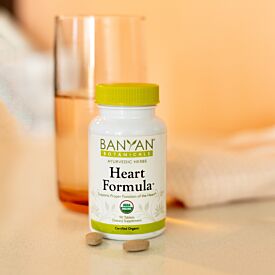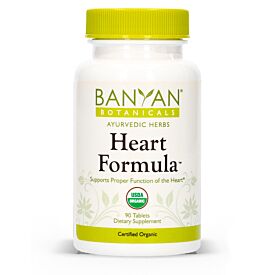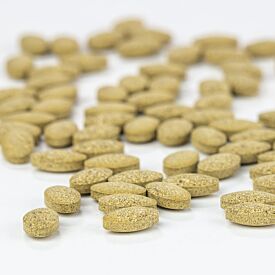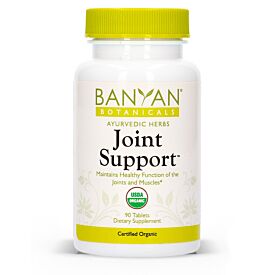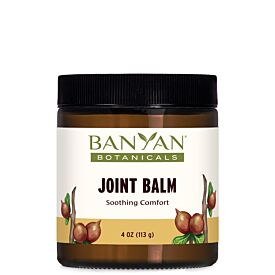The Benefits of Guggulu
Guggulu resin (Commiphora mukul) is prized in Ayurveda for its deeply penetrating action and unique ability to scrape away naturally accumulating toxins from the body channels.
Guggulu's powerful detoxifying and rejuvenating qualities can enhance the benefits of other herbs when used in combination, and as such it is the basis for an entire class of traditional Ayurvedic formulas known as guggulus.
In this article:
- What Is Guggulu?
- Guggulu Benefits and Uses
- How to Take Guggulu
- Modern Research on Guggulu
- Is Guggulu Resin Safe?
- Growing and Harvesting Banyan’s Guggulu
What Is Guggul? Characteristics of the Guggulu Tree
Guggul is the common name for the flowering mukul myrrh tree. It is a small, thorny tree that is most commonly found in the arid climates of India, in states such as Rajasthan and Gujarat.1, 2
Guggul also refers to the resinous substance formed from the sap of the guggul tree.
Guggul is known by the Sanskrit name “guggulu,” which means, “protects from disease”4 and because Banyan tends to offer herbs according to their Sanskrit names, guggul is offered as guggulu.
There are many varieties of guggulu—each with different uses—determined in part by the color and age of the resinous myrrh gum.5 It is said that the potency of guggul lasts up to 20 years.6

Guggul Benefits and Uses
In general, guggulu has an affinity for all of the tissues in the body as well as the circulatory, digestive, nervous, and respiratory systems.7 Guggul is known for its powerful detoxifying and rejuvenating qualities, which give it a number of beneficial attributes.
- Promotes detoxification and rejuvenation: With an ability to scrape away accumulated toxins from the body’s channels, guggulu is often used when detoxification is desired. At the same time, it helps to rejuvenate healthy tissues.
- Helps maintain healthy cholesterol levels already within the normal range: Guggul has a remarkable ability to support balanced cholesterol levels. In addition, guggul promotes supple arteries and tonifies the heart.8
- Supports healthy digestion: Thanks to its stimulating and heating nature, guggulu helps to kindle the digestive fire and promote the body’s natural digestive capacity.9
- Promotes healthy weight management: Guggulu supports healthy weight by working to remove accumulated natural toxins and excessive build-up of tissue. It also assists with the digestion of oils and fats, thereby supporting weight management in a number of ways.10
- Supports comfortable movement of the joints: Guggul’s scraping and detoxifying qualities act to clear toxins from the joints that can lead to discomfort. It simultaneously lubricates and rejuvenates the tissues within and around the joints, helping to promote comfortable movement within these delicate spaces.11
Guggulu in Ayurveda
Guggul is a very important herb in the Ayurvedic tradition. From an Ayurvedic perspective, it helps to balance all three doshas of vata, pitta, and kapha, though it is especially renowned for alleviating vata aggravations.12
In Ayurveda, different parts of plants are seen to work on different tissues in the body. Since guggul is made from the sap of the mukul myrrh tree, it has a strong connection with our own “sap,” or blood, known in Ayurveda as rakta dhatu.13
Guggulu also has an affinity with meda dhatu, the fat or adipose tissue. Guggul helps to clear excess unhealthy fat from the system with its pungent, bitter, and astringent tastes, its heating energy, and its pungent post-digestive effect.14
Because of its benefits for the joints, guggul also helps to bring balance to the musculoskeletal system, associated with asthi dhatu and mamsa dhatu in Ayurvedic terms.
Because of guggulu’s subtle and penetrating qualities, it is considered a yogavahi, meaning that it is often employed specifically to carry other substances deep into the tissues.15 The qualities of the other herbs help direct where exactly the guggulu travels in the body, and its combination with other herbs actually lends direction to its powerful detoxifying and rejuvenating qualities.

How to Take Guggul
Internal Use of Guggul
There are several ways to take guggulu supplements internally, either on its own or in combination with other herbs. Banyan Botanicals offers plain guggul in a powdered form and most of its traditional guggulu formulas in both powder and tablet forms.
Guggulu Powder
Guggulu powder offers the full experience of tasting the herb and also provides the most economical option for purchasing guggul. Guggul powder can be taken with water, milk, ghee, honey or another anupan, or carrier substance. Anupans act as a medium for delivering the herb to its intended destination and can also enhance its effect.
Taking Guggulu in a Blend
Among Banyan’s selection of herbal tablets, you will find a few blends that provide a convenient way to take guggul in combination with other herbs. These are ideal for those who are frequently traveling or on the go, as well as those who find the taste of guggulu a deterrent to taking it.
Aside from our many traditional guggulu formulas, guggulu can also be found in Joint Support, Women’s Natural Transition, and Heart Formula. These blends are gentle enough for daily use.
External Use of Guggul
Here are a few ways to use guggulu externally:
In a balm: You can find this herb in Banyan’s Joint Balm, which pairs perfectly with Joint Support tablets, as well as Trim Balm, designed to support healthy circulation, lymphatic flow, and weight management.
As a Paste: A paste of guggul can be applied to the exterior of the body to promote healthy skin, freedom of movement in the joints, and detoxification of the tissues.16
For Gargling: Guggul can be gargled or held in the mouth and then spit out to support healthy oral mucous membranes, teeth, and gums.17
Traditional Guggulu Supplements Available at Banyan Botanicals
Because guggulu works so successfully in combination with other herbs, it is rarely taken by itself. In fact, an entire class of unique formulations has been built around the use of guggulu.18
Banyan Botanicals carries several of these traditional guggulu supplements, known as guggulus. Potent and effective, these compounds are made with purified guggulu and a synergistic combination of other herbs.
Kanchanar Guggulu
Kanchanar guggulu benefits imbalances caused by deap-seated kapha dosha. Traditionally, this combination is considered particularly supportive of the thyroid gland and the lymphatic system.
Kanchanar is a very astringent herb that helps to clear the moist, stagnant qualities of kapha. When mixed with triphala, trikatu, and guggul, the combination is powerfully detoxifying and removes excess kapha from the tissues.
Future accumulation of kapha is also minimized by this formula because it kindles agni (the digestive fire) and promotes healthy elimination.
Yogaraj Guggulu
This synergistic combination of herbs is particularly adept at clearing excess vata from the body, especially when it is lodged in the musculoskeletal system. It is powerfully detoxifying and rejuvenating and it has a special affinity for the joints, muscles, and nerves.
Yogaraj guggulu benefits overall health and mobility by scraping and eliminating natural toxins from the joints and muscle tissues as it rejuvenates and strengthens the skeletal and neuromuscular systems.
Kaishore Guggulu
This preparation is especially balancing for pitta, particularly when it is disturbing the muscles and joints. Its main ingredients—guduchi, triphala, and trikatu—when combined with guggul, create a potent detoxifying and rejuvenating combination aimed primarily at removing deep-seated pitta from the tissues.
Kaishore guggulu benefits the health and proper function of the joints, muscles, and connective tissue by nourishing and strengthening the musculoskeletal system as a whole.
Punarnavadi Guggulu
This formula is very useful for clearing excess kapha from the urinary system, kidneys, heart, and joints. Its main ingredients—punarnava, triphala, and trikatu—when combined with guggul, create a detoxifying and rejuvenating combination that supports the healthy elimination of liquids.
In this way, punarnavadi guggulu benefits the water element in the body and helps to release deep-seated kapha from the tissues. It also supports the lymph and blood and encourages healthy circulation and comfortable movement of the joints.
Triphala Guggulu
This classic Ayurvedic preparation combines the detoxifying and rejuvenating actions of triphala with the deeply penetrating and cleansing actions of guggul. It decongests the channels of the body while scraping away natural toxins held within the tissues.
Triphala guggulu benefits those seeking healthy methods of weight management because it kindles digestion, promotes healthy metabolism, and releases excess kapha from the system. It also minimizes the accumulation of toxins in the GI tract, blood, and joints by supporting proper digestion and elimination.
Gokshuradi Guggulu
Gokshuradi guggulu benefits the overall health of the genitourinary tract and has traditionally been used to strengthen and tone the kidneys, bladder, urethra, and reproductive organs.
Its main ingredient, gokshura, is renowned for its rejuvenating action on the kidneys, the prostate, and the reproductive system. In combination with guggulu, triphala, and trikatu, this formula is very effective at detoxifying and balancing the urinary system.
Modern Research on Guggul
There has been significant scientific research evaluating the benefits of guggul, both on its own and as an ingredient in other herbal compounds.19 Below are examples that illustrate some of these research findings:
- “Guggulipid: A Promising Multi-Purpose Herbal Medicinal Agent.” PubMed Abstract. April 2020.20
- “Googling the Guggul (Commiphora and Boswellia) for Prevention of Chronic Diseases.” PubMed Abstract. August 2018.21
- “The Guggul for Chronic Diseases: Ancient Medicine, Modern Targets.” PubMed Abstract. November 2008.22
- “Therapeutic Effects of Guggul and its Constituent Guggulsterone: Cardiovascular Benefits.” PubMed Abstract. 2007.23
Is Guggul Resin Safe?
Guggul is a powerful herb and should be used judiciously. It can increase pitta, especially in combination with a pitta-aggravating lifestyle.24 Excessive use can lead to dryness of mouth, weight loss, impotency, skin disturbances, vertigo, and pathological changes in the liver or lungs.25
Contraindications
Guggul should be avoided when trying to become pregnant, during pregnancy, while breast-feeding, and in cases of excessive uterine bleeding, thyrotoxicosis, or acute kidney infection.26, 27 Avoid if there are known allergies to Commiphora mukul or other members of the Burseraceae family.28
A number of interactions between guggul and prescription medications have been observed; use caution when taking guggul in combination with hypo-glycemic medications, lipid-lowering agents, anti-coagulants, anti-platelets, anti-hypertensives, anti-diabetics, or estrogens.29, 30 If you are taking prescription medication of any kind, it is always best to check with your doctor before introducing an herbal regimen.
The Growing and Harvesting of Banyan’s Guggulu
Banyan’s guggulu is cultivated in India in the regions of Rajasthan, Karnataka, and Chhattisghar.
It takes several years for the trees to mature to a point that the sap can be harvested without causing damage to the well-being of the tree. When it does come time to harvest, circular incisions are made on the main stem of the tree, not beyond the thickness of the bark.
Guggul oozes out from these incisions as a pale yellow, aromatic fluid that quickly solidifies to form golden or reddish-brown tear-shaped resinous pieces. It is then manually scraped off with a knife.
The trees are tapped for resin from November through January, and a slow collection process continues through a nick on the bark of the tree every 10–15 days throughout the spring.
Sustainability of Guggulu
Guggul was once relatively abundant in many parts of India, and ironically, its success as an herbal remedy has led to its decline. It is very difficult to harvest the resinous sap without damaging the tree, leaving it susceptible to infection and decline.
In addition, the trees take several years to mature to the point where they can be safely harvested, as well as time to recover between harvest periods—without this recovery period, they are at risk of damage and even death.
For this reason, where and how guggul is harvested very directly impacts long-term sustainability. This is why we have gone through great lengths to develop relationships with small, private farms where sustainable farming can be ensured.
As a part of a larger conversation on the sustainability of Ayurvedic herbs, it’s important to know the journey of your herbs from seed to product. How are they grown and harvested? How is the landscape tended? How are the farmers treated? Knowing the full story can make all the difference in the quality of the product and the sustainability of those ingredients for generations to come.




